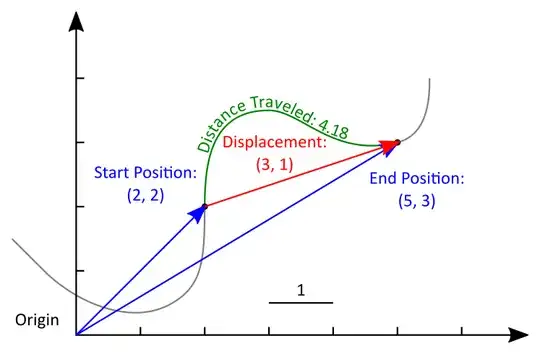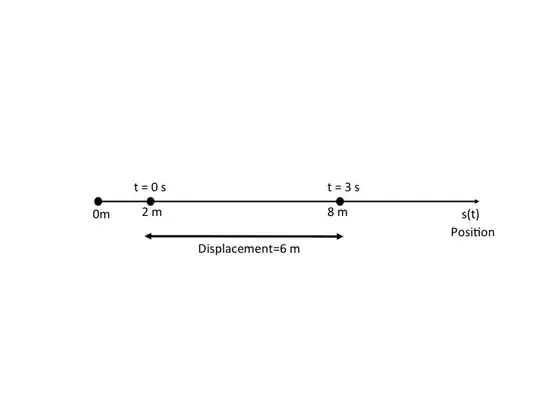Position and displacement are different, but you will find people use them as synonyms. For school purposes, its important to learn exactly how your textbook and teacher handle these terms and to understand that they are different. When you get out into the real world, you will find context makes it much more obvious what people are talking about, and you can ask for clarification if you need.
Positions are points in space. They are always defined within some coordinate system. Equations of motion are typically phrased in terms of position. There is always exactly one origin for a coordinate system like this, so we can unambiguously identify positions.
In your example, you are calculating positions. They give you an initial position of x=2m, and you calculate the final position to be x=8m
Displacement is a difference in position from some reference point. Most commonly this is the point at t=0, though that may not always be the case. In your example, the most reasonable assumption is that "displacement" means "displacement [from its initial position]." Since it starts at x=2m and ends at x=8m, the total displacement is 8m-2m=6m. If you want to make a displacement clear, the Delta ($\Delta$) symbol is typically used. I might write $\Delta x=6\;\text m$.
Displacement is commonly used when some measurements are more meaningful or easy to describe than others. Consider the movement of a piston up and down. If I have one big coordinate system for the entire engine, the piston may be at y=208mm at "top dead center" and y=186mm at the bottom of its movement. It's much easier for me to say "At the bottom of the stroke, the piston has been displaced 22mm from its position at top dead center" than it is to measure it from some origin. This is especially true if there's variability. There may be 5mm of variability in how high the piston is installed in the engine, but only 1mm of variability in its stroke length. Talking about displacement makes it easy to discard variability you didn't need.
Now comes the confusion. One can always talk about a position as a displacement from an origin. In fact, in some systems this is a far easier approach because it treats points and vectors as one and the same. Likewise, I can always define a reference frame centered on the initial position of an object, and then its position in that frame is the same as its displacement.
This is why the two terms are easy to confuse. While they are different, we will often smoothly flow from one term to another. In the real world, ask questions. In the world of test taking, learn the language hints your textbooks use and pass your tests.
Which brings us to distances. A distance is a length of a line in space. The distance between point A and point B is the length of a line between them. However, we can also talk about the length of arbitrary curves, not just straight lines. This is what your homework problem is trying to do. I believe it was supposed to read "distance traveled," which is the length of the curve tracing the path the object takes.
In your case, the object travels in one direction from t=0 until t=2, when its velocity is zero, then it travels the other direction from t=2 to t=3. Thus the length of this curve is the length between where it was at t=0 and where it was at t=2, plus length between where it was a t=2 and t=3. At t=2, x=10, so the particle has traveld from x=2 to x=10, a distance of 8. Then it travels from x=10 at t=2 to x=8 at t=3, for an additional distance of 2. The total distance traveled will be 10m.

